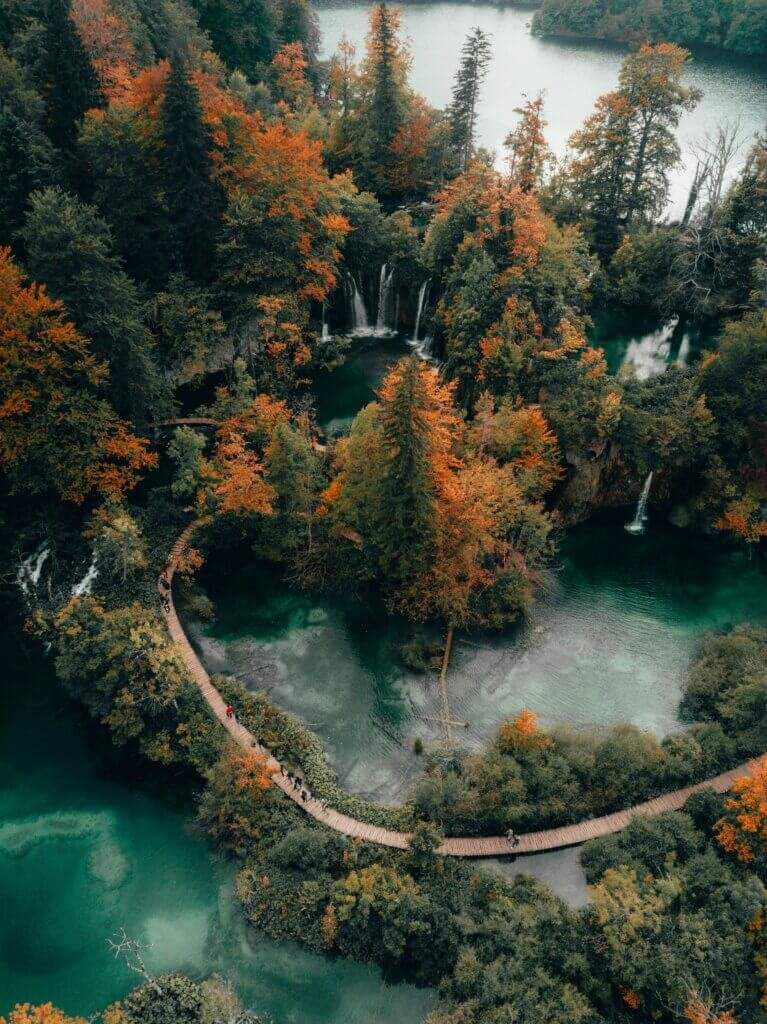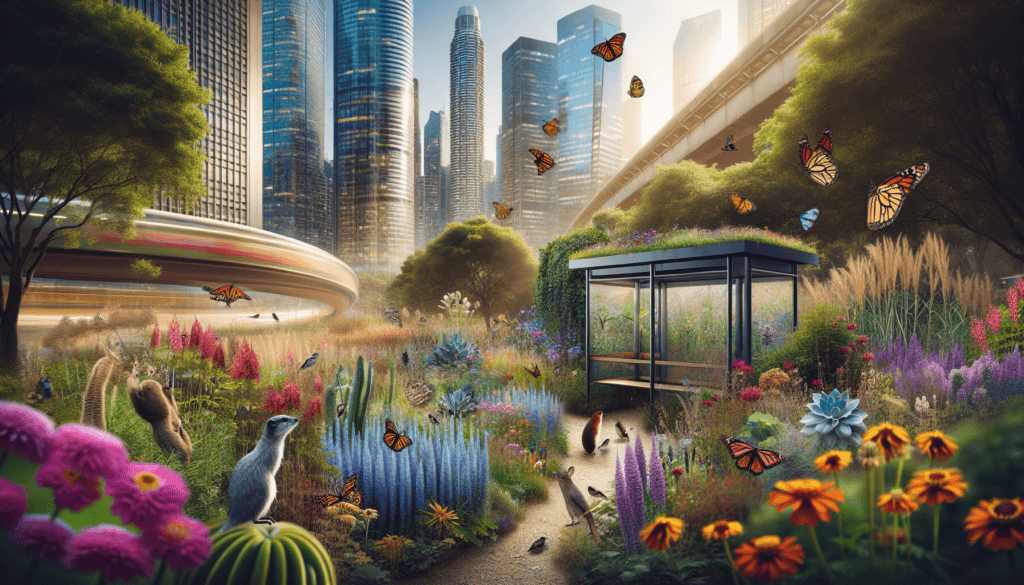Imagine transforming your outdoor space into a thriving haven for wildlife right in the heart of the city. In this article, we will explore the exciting world of creating a wildlife-friendly urban garden habitat. Discover how you can attract a diverse range of creatures, from colorful butterflies and buzzing bees to playful squirrels and melodious songbirds. With a few simple tips and tricks, you can not only create a beautiful green space but also contribute to the preservation of our precious wildlife. Get ready to embark on an adventure that will bring nature closer to home than ever before.

The Importance of Creating a Wildlife-Friendly Urban Garden Habitat
In today’s urban landscape, the importance of creating a wildlife-friendly garden habitat cannot be overstated. As cities continue to expand, natural habitats are being destroyed, and the biodiversity of our ecosystems is being threatened. By designing and maintaining a garden that welcomes wildlife, you can play a crucial role in promoting biodiversity, supporting declining wildlife populations, and creating a balance in the ecosystem.
Promoting Biodiversity in Urban Areas
Urban areas often lack the diverse range of plant and animal species found in natural habitats. However, by incorporating specific elements into your garden design, you can help promote biodiversity in these urban environments. By providing food sources, shelter, and breeding grounds for a variety of species, you can create a microcosm of nature within your own backyard.
Supporting Declining Wildlife Populations
Many species of wildlife are experiencing declining populations, primarily due to habitat loss and fragmentation. By creating a wildlife-friendly garden habitat, you can provide a safe haven for these creatures, allowing them to thrive and potentially reversing the decline in their populations. Your garden can serve as a sanctuary, supporting a variety of species, including birds, butterflies, bees, reptiles, amphibians, and more.
Creating a Balance in the Ecosystem
Urban ecosystems are often imbalanced, with certain species flourishing while others struggle. By designing your garden to attract a wide range of wildlife, you can help restore this balance. For example, attracting birds to your garden can help control insect populations naturally, reducing the need for harmful pesticides. Similarly, inviting butterflies and bees can aid in plant pollination, contributing to a healthier and more sustainable ecosystem.
Designing Your Wildlife-Friendly Garden
Creating a wildlife-friendly garden begins with thoughtful design and careful selection of plants and features. Here are some key considerations to keep in mind:
Choosing Native Plants
Native plants are adapted to thrive in your local environment and are an essential component of a wildlife-friendly garden. They provide food and shelter for native wildlife, and because they have evolved alongside these animals, they are often better suited for their needs. Research and choose native plants that are compatible with your soil type, climate, and available space.
Providing Diverse Habitats
A variety of habitats within your garden will attract a diverse range of wildlife. Include features such as trees, shrubs, grasses, and flowers to create different habitats and niches. This will attract a wider range of species, as each will have its own preferred habitat requirements. For example, providing dense shrubs for nesting birds, tall grasses for insects and small mammals, and flowering plants for butterflies and bees.
Creating Water Features
Water is essential for wildlife, and incorporating water features into your garden can greatly enhance its wildlife-friendliness. Options can range from a simple birdbath to a more elaborate pond or even a small bog garden. Ensure the water feature has a shallow area for different species to access and provide a source of fresh water all year round.
Attracting Birds to Your Urban Garden
Birds are a beautiful and welcome addition to any garden. By incorporating bird-friendly elements into your urban garden, you can attract a wide array of species and create a bird-friendly haven.
Planting Trees and Shrubs as Nesting Sites
Trees and shrubs provide vital nesting sites for birds. Choose a variety of sizes and types that are suitable for your garden, considering factors such as space, sunlight, and soil conditions. Native species are often best, as they provide the necessary food sources and shelter for local bird populations.
Installing Bird Feeders and Bird Baths
Bird feeders and bird baths are a great way to attract and support birds in your garden. Choose feeders that offer a variety of bird-friendly foods, such as seeds, nuts, and suet. Ensure the bird bath is shallow and has a rough surface for birds to grip onto while bathing. Keep the feeders and baths clean and well-maintained to prevent the spread of diseases.
Avoiding the Use of Chemicals
Chemicals such as pesticides and herbicides can be harmful to birds and their food sources. Avoid using these chemicals in your garden, as they can contaminate the environment and affect bird populations. Embrace natural pest control methods and choose organic alternatives to keep your garden healthy and safe for birds.
Welcoming Butterflies and Bees
Butterflies and bees are crucial pollinators in our ecosystems and are known for their graceful beauty. By incorporating elements that attract these creatures, you can contribute to their conservation efforts.
Planting Butterfly and Bee-Friendly Flowers
Choose a variety of flowering plants that are known to attract butterflies and bees. Look for nectar-rich flowers with bright colors, as these are particularly attractive to these pollinators. Some popular options include lavender, coneflower, milkweed, and salvia. Plant these flowers in clusters to provide a concentrated food source for these creatures.
Setting Up Butterfly and Bee Houses
Butterflies and bees use specific structures for shelter and as nesting sites. Butterfly houses and bee houses mimic their natural habitats and provide a safe place for them to rest and reproduce. These structures can be purchased or easily built at home using materials like wood and bamboo.
Avoiding the Use of Pesticides
Pesticides, even those labeled as bee-friendly, can still be harmful to butterflies and bees. Avoid using pesticides in your garden to protect these important pollinators. Instead, embrace natural pest control methods such as companion planting and biological controls to maintain a healthy garden ecosystem.

Inviting Reptiles and Amphibians
Reptiles and amphibians are often misunderstood and underappreciated creatures in the garden. However, they play a crucial role in maintaining a balanced ecosystem and can be fascinating additions to your wildlife-friendly garden.
Providing Shelter and Hiding Places
Reptiles and amphibians require suitable shelter and hiding places to feel safe and thrive in your garden. Incorporate rock piles, log piles, and dense vegetation to create these habitats. Add a variety of plant species with varying heights, as this will provide hiding places for different-sized creatures.
Creating a Pond or Bog Garden
Water features such as ponds and bog gardens are ideal for attracting reptiles and amphibians. These habitats not only provide a source of water but also attract insects and other invertebrates, which are an essential food source for these creatures. Ensure the pond or bog garden has shallow and deep areas, as well as rocks and logs for basking and hiding.
Avoiding the Use of Herbicides
Herbicides and weed killers can be detrimental to reptiles and amphibians, as these chemicals can directly harm them or affect their food sources. Instead of relying on herbicides, embrace natural weed control methods such as manual weeding, mulching, or using organic alternatives.
Cultivating a Wildlife-Friendly Lawn
Lawns are a dominant feature of many urban gardens, but they often lack biodiversity and are heavily managed. By adopting wildlife-friendly practices, you can transform your lawn into a thriving habitat for a variety of species.
Reducing Lawn Area
Consider reducing the size of your lawn and replacing it with other wildlife-friendly elements such as native flower beds, meadows, or even vegetable gardens. This will not only increase biodiversity but also reduce the amount of water, fertilizer, and maintenance required for your garden.
Leaving Areas Untouched or Less Managed
Allow some areas of your lawn to grow naturally and become a haven for wildlife. This could be achieved by leaving patches of long grass or allowing certain plant species to flourish. These areas will attract a variety of insects, small mammals, and birds that rely on undisturbed habitats.
Using Natural Lawn Care Practices
Adopt natural lawn care practices that reduce the need for chemicals and promote a healthy ecosystem. This includes proper watering techniques, mowing at a higher height, and applying organic fertilizers. A healthy lawn will attract a variety of wildlife, including insects and birds that rely on the grasses as a food source.

Managing Pest Control Naturally
Pest control is an important aspect of garden maintenance, but it can often involve the use of harmful chemicals. By managing pests naturally, you can maintain a healthy garden ecosystem while minimizing harm to wildlife.
Encouraging Natural Predators
Natural predators, such as birds, ladybugs, and beneficial insects, can help control pests in your garden. Attract these predators by providing shelter, food sources, and nesting sites. Consider incorporating birdhouses and insect hotels into your garden to create a welcoming habitat for these helpful creatures.
Using Companion Planting
Companion planting involves strategically placing certain plant species together to benefit each other. Some plants release natural repellents or attract beneficial insects that can help control pests. Research companion planting techniques that work well in your region and incorporate them into your garden design.
Implementing Integrated Pest Management (IPM)
Integrated Pest Management (IPM) is an eco-friendly approach to pest control that focuses on using a combination of techniques and strategies. This involves identifying pests, monitoring their populations, and using the least harmful methods to control them. IPM emphasizes prevention, cultural practices, and biological controls, rather than relying solely on chemical pesticides.
Safe Garden Practices for Wildlife
Whether intentional or unintentional, certain garden practices can pose risks to wildlife. By adopting safe garden practices, you can minimize these risks and create a safe and welcoming environment for wildlife.
Avoiding Harmful Garden Products
Many garden products, such as certain fertilizers, weed killers, and insecticides, can be harmful to wildlife. Always read labels carefully and choose products that are safe for the environment. Consider using organic alternatives or homemade remedies whenever possible.
Reducing Light Pollution
Excessive artificial lighting can disrupt the natural behavior of wildlife, especially nocturnal creatures. Minimize light pollution by using motion sensor lights or shielding outdoor lighting to direct light downward. This will help preserve the natural light cycle and prevent confusion or disorientation among wildlife.
Preventing Wildlife Hazards
Certain garden features can pose hazards to wildlife if not properly managed. For example, open water features may pose a drowning risk to small mammals or birds. Ensure any potential hazards, such as uncovered wells or toxic plants, are properly addressed and made inaccessible to wildlife. Regularly inspect your garden for any potential risks and take appropriate measures to prevent accidents.

Educating and Inspiring Others
Creating a wildlife-friendly garden is a wonderful way to contribute to conservation efforts and inspire others to do the same. By sharing your knowledge and experiences, you can encourage your community to embrace wildlife-friendly practices.
Sharing Knowledge with the Community
Share your experiences and knowledge with neighbors, friends, and local gardening groups. Offer to give presentations or workshops on wildlife-friendly gardening techniques. By spreading the word and providing practical advice, you can inspire others to create their own wildlife-friendly habitats.
Engaging Children and Schools
Children are the future custodians of our environment, and engaging them in wildlife-friendly gardening can foster a love and appreciation for nature. Collaborate with local schools or youth organizations to create educational programs, hands-on activities, or even school gardens that promote wildlife conservation and sustainable gardening practices.
Promoting Wildlife Conservation
Take an active role in promoting wildlife conservation by supporting and engaging with local wildlife and conservation organizations. Attend workshops and events, volunteer your time, or donate to relevant causes. By actively participating in conservation efforts, you can make a meaningful impact on wildlife preservation beyond your own garden.
Monitoring and Enjoying the Wildlife in Your Garden
Creating a wildlife-friendly garden is not just about providing a habitat; it is also about observing and enjoying the wildlife that visits. By taking the time to monitor and appreciate the creatures that call your garden home, you can deepen your connection with nature.
Observing and Recording Wildlife Sightings
Spend time in your garden observing the behavior of visiting wildlife. Take note of the different species you encounter and keep a record of your observations. This can be as simple as a journal or a more formal citizen science project. By recording your sightings, you can contribute valuable data to research and conservation efforts.
Creating Seating and Viewing Areas
Designate seating and viewing areas in your garden where you can relax and observe wildlife without disturbing their natural activities. This could be as simple as a bench or a designated patio area with comfortable seating. Position these areas strategically to allow for optimal views of your garden’s wildlife.
Encouraging Wildlife Photography
Photography is an excellent way to capture and appreciate the beauty of wildlife in your garden. Set up a designated area for wildlife photography, complete with a hide or camouflaged structure. By capturing these moments, you can share the beauty of your wildlife-friendly garden with others and inspire them to create their own havens for creatures great and small.
In conclusion, creating a wildlife-friendly urban garden habitat is not only beneficial to the environment but also a rewarding and enjoyable endeavor. By incorporating native plants, diverse habitats, water features, and safe practices, you can attract and support a wide range of wildlife in your garden. From birds and butterflies to reptiles and amphibians, every species that finds sanctuary in your garden contributes to the overall health and balance of our ecosystem. So, roll up your sleeves, grab your gardening tools, and embark on a journey to create a vibrant and thriving wildlife-friendly garden in your urban oasis.



